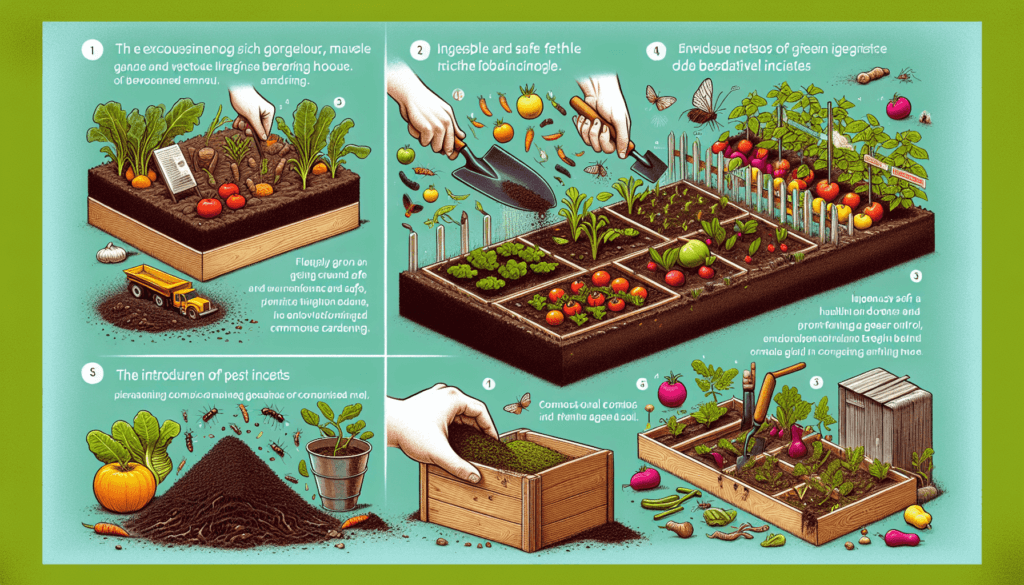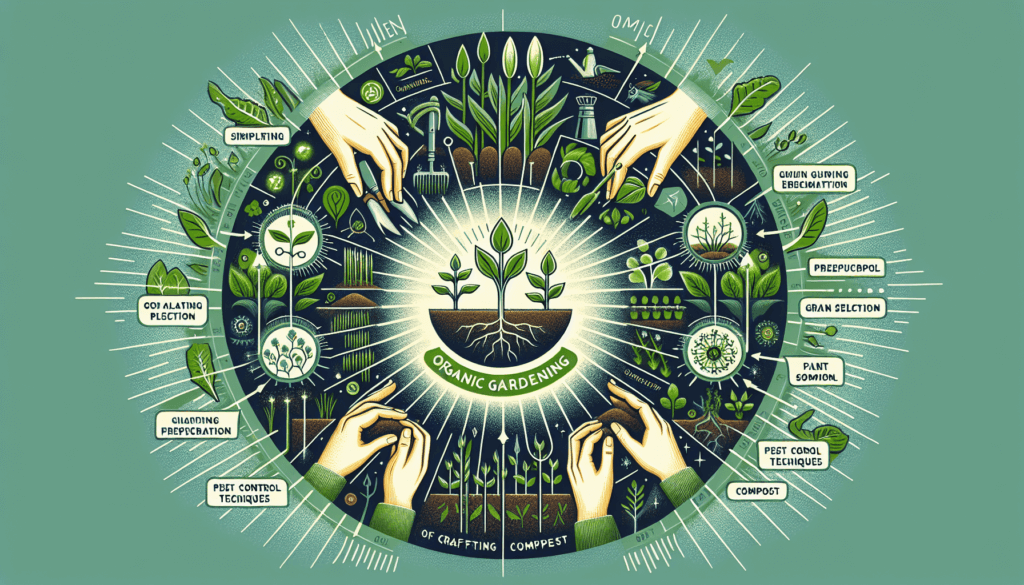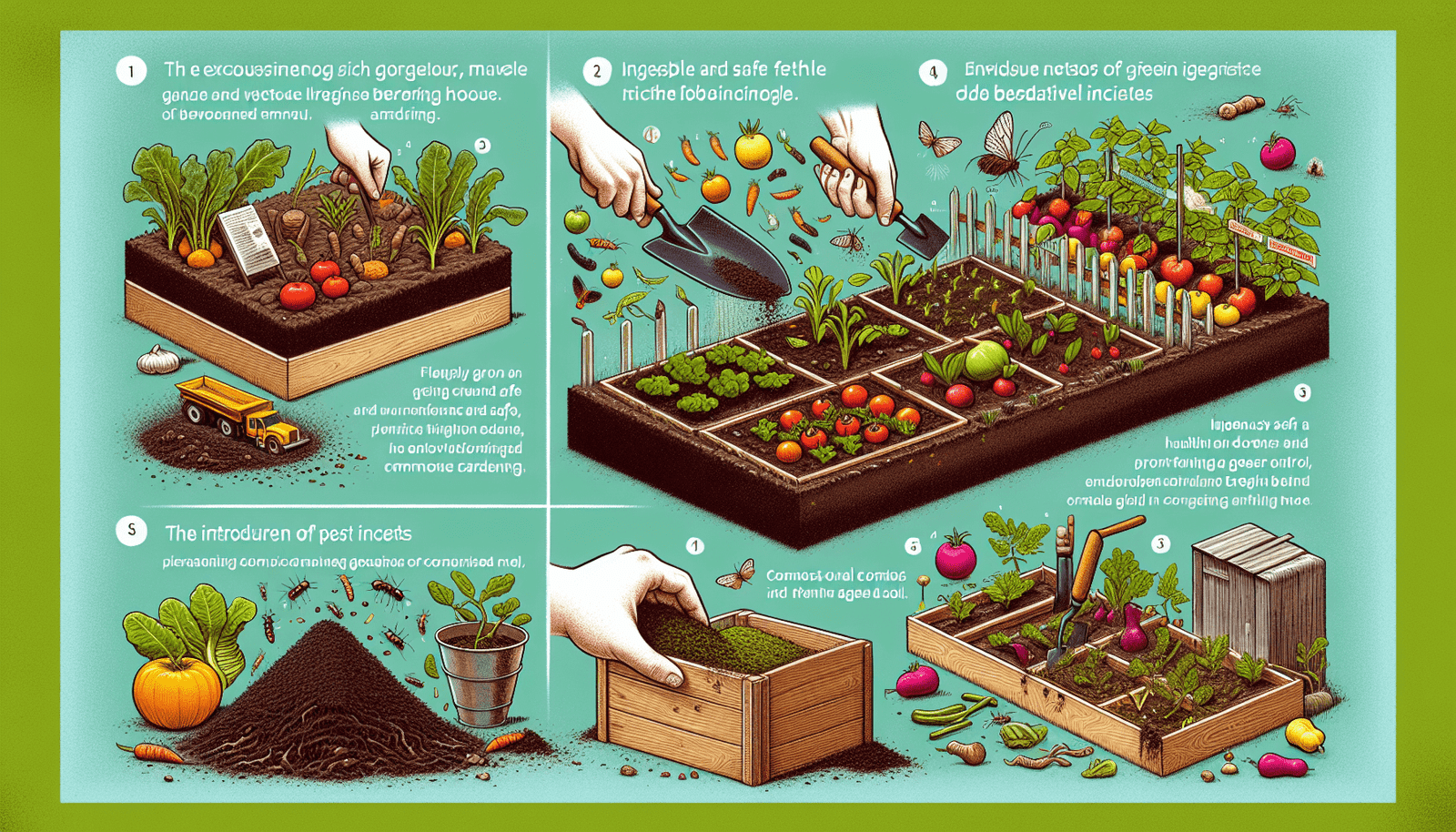Have you ever wanted to try your hand at organic gardening? Well, you’re in luck because organic gardening can be as simple or complex as you want it to be. Whether you’re a beginner or an experienced gardener, there are plenty of options for you to explore in the world of organic gardening. From growing your own herbs and vegetables in pots on your patio, to creating a full-fledged sustainable garden in your backyard, the possibilities are endless. So, don’t be intimidated by the idea of organic gardening – it’s a fun and rewarding hobby that anyone can enjoy!

Benefits of Organic Gardening
Environmental benefits
Organic gardening offers numerous environmental benefits. By avoiding the use of synthetic fertilizers, pesticides, and herbicides, organic gardeners help to reduce the pollution of soil, water, and air. Additionally, organic gardening promotes biodiversity by encouraging the presence of beneficial insects, birds, and other animals. Furthermore, organic gardening practices prioritize the conservation of natural resources, such as water and energy, making it a sustainable choice for environmentally conscious individuals.
Health benefits
One of the major advantages of organic gardening is the potential health benefits it offers. By growing and consuming organic produce, you can reduce your exposure to harmful chemicals and pesticides. Organic fruits and vegetables are grown without synthetic pesticides, making them a safer option for you and your family. Moreover, organic farming methods focus on improving soil health, which in turn enhances the nutrient content of the produce. This means that organic fruits and vegetables can be more nutrient-dense, offering you greater nutritional value.
Cost savings
Contrary to popular belief, organic gardening can actually save you money in the long run. While the upfront costs of organic gardening may be slightly higher due to the purchase of organic seeds and natural gardening inputs, such as compost and mulch, the benefits are worth it. By growing your own organic produce, you can significantly reduce your grocery bills, especially during the harvest season. Additionally, organic gardening can contribute to overall cost savings by reducing healthcare expenses related to pesticide exposure and promoting a healthier lifestyle.
Essential Elements of Organic Gardening
Soil preparation
One of the essential elements of organic gardening is proper soil preparation. Healthy soil is the foundation for successful plant growth. Organic gardeners focus on improving soil fertility and structure by adding organic matter, such as compost and manure, which provide essential nutrients to the plants. Additionally, organic gardeners avoid the use of synthetic fertilizers that can harm the soil microbiome and opt for natural alternatives to nourish their gardens.
Composting
Composting plays a vital role in organic gardening. It involves the decomposition of organic materials, such as kitchen scraps, yard waste, and plant trimmings, to create nutrient-rich compost. This compost can then be used as a natural and sustainable fertilizer for the garden. Composting not only reduces waste going to landfills but also improves soil health, enhances water retention, and promotes beneficial microbial activity.
Mulching
Mulching is another key element of organic gardening. By covering the soil surface with organic materials, such as straw, wood chips, or leaves, gardeners can conserve moisture, suppress weed growth, and regulate soil temperature. Organic mulches also break down over time, adding nutrients and improving soil structure. This practice not only creates a more favorable environment for plant growth but also reduces the need for excessive watering and weeding.
Crop rotation
Crop rotation is an important technique used in organic gardening to manage pests, diseases, and nutrient imbalances. By rotating the types of crops grown in different areas of the garden each year, gardeners disrupt the life cycles of pests and diseases, reducing the risk of infestations. Additionally, crop rotation helps maintain soil health by preventing the depletion of specific nutrients and promoting a balanced ecosystem.
Natural pest control
Organic gardeners rely on natural pest control methods to manage pests without the use of harmful chemicals. This includes attracting beneficial insects, such as ladybugs and lacewings, that feed on garden pests like aphids. Additionally, organic gardeners employ physical barriers, such as insect netting or row covers, to protect plants from pests. By integrating these natural pest control methods, organic gardeners maintain a healthy and balanced ecosystem in their gardens.
Simple Organic Gardening Techniques for Beginners
Start with container gardening
Container gardening is an excellent way for beginners to start their organic gardening journey. It allows you to grow plants in pots or containers, making it ideal for those with limited space or poor soil conditions. With container gardening, you have more control over soil quality and can easily move plants to optimize sunlight exposure. Whether you choose to grow herbs, vegetables, or flowers, container gardening is a simple and convenient approach for beginners.
Choose easy-to-grow plants
When starting out in organic gardening, it’s important to select plants that are known to be easy to grow. This will increase your chances of success and boost your confidence as a gardener. Some popular choices for beginners include tomatoes, lettuce, radishes, and herbs like basil and mint. These plants tend to be resilient, require minimal maintenance, and provide a rewarding gardening experience.
Use organic fertilizers
Organic fertilizers are a key component of successful organic gardening. They provide essential nutrients to plants while improving soil fertility and structure. Organic options include compost, well-rotted manure, and various organic fertilizer blends available in garden stores. By using organic fertilizers, you ensure that your plants receive the necessary nutrients without the risk of harmful chemical residues.
Practice companion planting
Companion planting is the strategic pairing of plants that benefit each other when grown together. This technique helps maximize space, control pests, and improve overall plant health. For example, planting marigolds alongside tomatoes can deter nematodes, while growing aromatic herbs like rosemary and lavender can repel pests. By integrating companion planting into your organic garden, you can create a harmonious and beneficial plant community.
Advanced Techniques for Experienced Organic Gardeners
Developing a permaculture system
Permaculture is a holistic approach to gardening and agriculture that aims to create self-sustaining ecosystems. It involves designing landscapes that mimic natural ecosystems and maximize resources. Permaculture techniques include creating guilds, designing water catchment systems, and implementing regenerative practices. By developing a permaculture system, experienced organic gardeners can create resilient and abundant gardens that require minimal external inputs.
Using biodynamic gardening methods
Biodynamic gardening is a holistic and regenerative approach that goes beyond organic practices. It follows the principles and practices developed by Austrian philosopher Rudolf Steiner. Biodynamic gardeners focus on creating a balanced and harmonious relationship between the soil, plants, animals, and the cosmos. This includes using specific preparations, composting techniques, and timing activities based on celestial and lunar cycles. By incorporating biodynamic methods, experienced organic gardeners can enhance the vitality and biodiversity of their gardens.
Integrating livestock in gardening practices
For experienced organic gardeners who have space and resources, integrating livestock into gardening practices can provide additional benefits. Chickens, for example, can help control pests, provide natural fertilizer through their droppings, and even help with soil cultivation through scratching. Similarly, rabbits can produce nutrient-rich manure that can be used as fertilizer. By incorporating livestock, gardeners can create more closed-loop systems and further increase the sustainability of their organic gardens.

Tools and Equipment for Organic Gardening
Garden fork
A garden fork is a versatile tool that every organic gardener should have. It is used for loosening soil, breaking up clumps, and turning compost. A garden fork with sturdy tines is essential for proper soil preparation and aeration.
Hand trowel
A hand trowel is a small, handheld tool that is perfect for planting and transplanting seedlings, bulbs, and small plants. It allows for precision and control, making it a must-have for any organic gardener.
Pruning shears
Pruning shears, also known as secateurs, are used for cutting and shaping plants. They are essential for pruning and trimming plants to maintain their health and appearance. Choose high-quality pruning shears with a sharp blade for clean cuts.
Compost bin
A compost bin is a container used for holding compostable materials, such as kitchen scraps and yard waste. It is an integral part of organic gardening, as it allows you to create nutrient-rich compost for your garden. There are various types of compost bins available, including traditional bins, tumblers, and worm composting systems.
Rain barrel
A rain barrel is a container used to collect and store rainwater for later use in the garden. It helps conserve water resources and provides a sustainable source of irrigation. By utilizing rainwater, organic gardeners can reduce their water consumption and reliance on municipal water supplies.
Maintaining Organic Garden
Regular watering
Proper watering is crucial for maintaining an organic garden. While the frequency and amount of water needed may vary depending on the plants and weather conditions, it’s important to consistently monitor soil moisture levels. Avoid overwatering, as it can lead to root rot and other water-related issues, and aim to water deeply to encourage healthy root growth.
Weeding
Weeding is an ongoing task in organic gardening. By regularly removing weeds, you prevent them from competing with your plants for water, nutrients, and sunlight. Manual weeding techniques, such as hand-pulling or using a hand cultivator, are preferred in organic gardening to avoid the use of herbicides.
Monitoring for pests and diseases
Regular monitoring for pests and diseases is essential to catch any issues early and prevent damage to your plants. Inspect your garden regularly, paying attention to signs of insect pests, fungal diseases, or nutrient deficiencies. By promptly addressing these problems using organic pest control methods or appropriate treatments, you can maintain the health of your plants.
Pruning and trimming
Pruning and trimming are important maintenance tasks in organic gardening. By removing dead or diseased branches, you improve plant health and promote proper air circulation. Additionally, pruning can shape plants and encourage more vigorous growth. Use clean and sharp tools when pruning to minimize the risk of spreading diseases.
Crop management
Proper crop management is essential to optimize plant growth and productivity in an organic garden. This includes monitoring plant spacing, providing support for vining crops, and practicing proper harvesting techniques. By managing your crops effectively, you can minimize the risk of pest and disease problems, conserve resources, and maximize yields.
Building Healthy Soil in Organic Gardening
Testing and improving soil fertility
Regular soil testing is vital to ensure the fertility of your garden soil. By understanding the nutrient levels and pH of your soil, you can make informed decisions about soil amendments. Organic gardeners often use natural amendments, such as compost, aged manure, and organic fertilizer blends, to improve soil fertility and balance nutrient levels.
Adding organic matter
Adding organic matter is a fundamental practice in organic gardening. Organic matter, such as compost, leaf mold, and cover crops, improves soil structure, increases water-holding capacity, and enhances nutrient availability. Regularly incorporating organic matter into your garden beds helps replenish nutrients and promotes a healthy soil ecosystem.
Using cover crops
Cover crops are plants grown specifically for the purpose of improving soil health. They help prevent erosion, suppress weeds, and add organic matter to the soil when they are turned under. Popular cover crops for organic gardens include legumes like clover or hairy vetch, which fix nitrogen in the soil, as well as grasses like rye or barley, which provide excellent ground cover.
Avoiding chemical fertilizers
One of the key principles of organic gardening is to avoid the use of chemical fertilizers. Chemical fertilizers can harm beneficial soil microorganisms and contribute to environmental pollution. Instead, organic gardeners rely on natural fertilizers, such as compost, manure, and organic plant-based fertilizers, to nourish their plants and maintain soil health.
Choosing the Right Plants for Organic Gardening
Native and heirloom varieties
When selecting plants for your organic garden, consider choosing native and heirloom varieties. Native plants are adapted to the local environment, making them more resilient to pests and diseases. Heirloom varieties, on the other hand, are open-pollinated plants that have been passed down through generations. They often possess unique flavors, nutritional profiles, and characteristics that are lost in modern hybrid varieties.
Disease-resistant plants
To minimize the risk of diseases in your organic garden, choose disease-resistant plant varieties whenever possible. Many plant breeders and seed companies offer disease-resistant options for common garden crops like tomatoes, cucumbers, and peppers. These varieties have been bred to withstand specific diseases, reducing the need for chemical treatments.
Beneficial companion plants
Incorporating beneficial companion plants in your organic garden can help improve plant health and deter pests. For example, planting aromatic herbs like basil, oregano, and cilantro near susceptible crops can repel insect pests. Similarly, interplanting flowers like marigolds and calendula can attract beneficial insects, such as ladybugs and hoverflies, that will help control garden pests.
Organic Pest Control Methods
Attracting beneficial insects
One effective pest control method in organic gardening is attracting beneficial insects to your garden. Beneficial insects, like ladybugs, lacewings, and parasitic wasps, feed on garden pests and help maintain a healthy balance in the ecosystem. Planting flowers with nectar-rich blooms, providing habitat with native plants, and limiting pesticide use can all encourage beneficial insects to frequent your garden.
Using organic insecticides
In situations where pest populations are high and natural control methods are insufficient, organic gardeners may choose to use organic insecticides. Organic insecticides are derived from natural sources, such as plant extracts or insect predators, and are considered safer for the environment and beneficial insects compared to synthetic alternatives. However, it’s important to use organic insecticides sparingly and as a last resort, as they can still harm non-target insects.
Creating physical barriers
Physical barriers can be an effective way to protect your plants from pests in organic gardening. For example, constructing a fence around your garden can deter larger pests like rabbits or deer. Additionally, using row covers or netting can prevent insect pests from reaching your plants while still allowing sunlight, water, and air to penetrate.
Crop rotation to deter pests
Crop rotation is not only beneficial for soil fertility but also helps deter pests in organic gardening. Different plant families attract different types of pests, and by rotating crops each season, you can interrupt the life cycles of pests and reduce the likelihood of infestations. This practice is particularly useful for managing soil-based pests and diseases. However, be mindful of specific crop rotation guidelines to ensure optimal results.
Harvesting and Preserving Organic Produce
Picking at the right time
Harvesting produce at the right time is crucial to ensure optimal flavor, texture, and nutritional content. Each crop has specific indicators of ripeness, such as color, size, and texture. Proper timing of harvest also helps prevent overripening, which can attract pests or reduce the quality of the produce. Refer to gardening resources or seed catalogs for guidance on when to harvest your specific crops.
Proper storage techniques
To maximize the shelf life of your harvested organic produce, it’s important to employ proper storage techniques. Different fruits and vegetables have varying storage requirements, including temperature, humidity, and ventilation. Some crops, like root vegetables, can be stored in a cool and dark place, while others, like leafy greens, may require refrigeration. Research the best storage methods for each crop to maintain freshness and quality.
Canning and freezing
Canning and freezing are popular preservation methods for organic produce. Canning involves heat processing fruits and vegetables in jars, effectively killing bacteria and extending shelf life. Freezing, on the other hand, involves blanching or partially cooking crops before storing them in sealed containers in the freezer. Both methods allow you to enjoy your homegrown organic produce throughout the year.
Drying herbs and vegetables
Drying is a traditional method of preserving herbs and certain vegetables. It involves removing moisture from the plant material, which inhibits the growth of bacteria and molds. Herbs can be air-dried in small bundles and hung upside down in a dry, well-ventilated area. Some vegetables, like tomatoes or peppers, can be dried in the sun or using a dehydrator. Dried herbs and vegetables can be used in cooking or infused into oils and vinegars for added flavor.
In conclusion, organic gardening offers a multitude of benefits for both the environment and individuals. From promoting biodiversity and reducing chemical pollution to providing healthier produce and cost savings, organic gardening aligns with sustainable, eco-friendly practices. Whether you are a beginner or an experienced gardener, there are various techniques, tools, and methods available to suit your level of expertise and commitment. By embracing organic gardening, you can create a thriving, productive garden while nurturing the health of both people and the planet.


